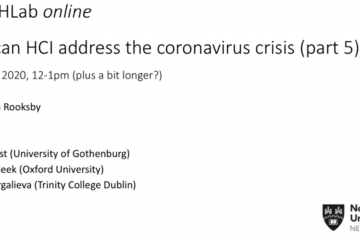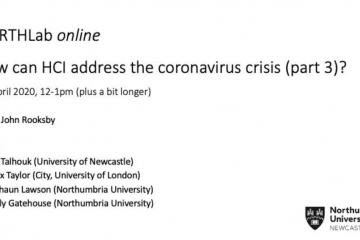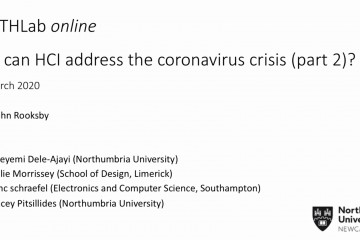Adding to Part 1, Part 2 and Part 3 of our NORTH Lab online panel series, I’ve once again summarised the discussions and presentations below. It’s interesting to see how discussions evolve week on week, and this time they seemed to be somewhat more practical, thinking about how as researchers we can collect data in this context, and how our work can help inform and improve healthcare services and government communications. But of course, debates on the broader implications and the ethics of how technology is designed are still very much present.
Juan Fernando Maestre (Indiana University Bloomington) – Conducting HCI research remotely
Fernando has been studying the impact of technology with and for stigmatised populations, especially looking at people with HIV. One of the challenges he faced was recruiting people for face to face settings because they didn’t want to necessarily reveal their identity. In his talk he walked us through two approaches he’s taking in research and how these might be useful for others doing remote data collection.
As a result, he has been using the ARC method, developed by Haley MacLeod as a way to study distributed communities, which in her case were people living with rare conditions who could not be collocated. The ARC method stands for Asynchronous Remote Communities and often relies on Facebook as a platform to create private groups to which people recruited on- and offline can be added and given weekly activities to complete. Activities can include things such as surveys, photo elicitation, user testing, vignettes, focus groups, chat interviews, etc. Fernando has been using this technique in his work over the course of 8-week long studies, asking participants to complete activities and share them with the rest of the group or privately through a direct message. While this might depend on the nature of the project, there seems to be a high response rate with sustained engagement throughout the study. This method also allows participants to ask questions to the researchers at any point, allowing for more transparency and direct contact. While participation within the group continued even after the study was complete, this has since died down, suggesting that any secondary outcomes may not always have long term effects.
Moving forward with his work, the next stage of Fernando’s work will be looking at remote co-design sessions. These can be planned around 3 workshops:
- Generative workshop: using a virtual whiteboard to sensitise participants to the topic and walk through an ideation process. A useful platform for this is something like www.miro.com
- Iterative workshop: following the first workshop, a research might be able to create a series of sketches that participants can then comment on or iterate in the second workshop. Tools useful for this stage include www.explaineverything.com
- Evaluative workshop: where the final feedback from participants can be gained. This is a stage where using the ARC method and a facebook group, could be relevant.
Dr Nikki Newhouse (Oxford University) – Can HCI save the NHS?
As a qualitative methodologist, with an interest in HCI, Nikki has been using qualitative and participatory methods, in her work with clinical trial primary care in Oxford.
The current message in the UK healthcare system is that digital is good, and more recently this message has become even more nuanced, with an emphasis on “digital transformation”, through a persistent push to get more and more people online in order to enable cost effective self-management. However, the reality of getting people online is different, particularly with telemedicine (e.g. health apps, trackers, etc.). The risk is for example that the increased and uniformed self-tracking, actually creates more visits to the GP, and while there might be short term benefits, we don’t know enough of what works well, why, for whom and what are the long-term effects of digital health. More critically, we don’t know how people engage with this technology and there is no one retention story to help keep people coming back.
This is where multidisciplinary work holds particular promise. In particular, as crude simplification we can think of this as a continuum with behavioural science at one end and HCI at the other end. On one side, behavioural science takes a linear approach, prioritises efficacy, can be compared to the waterfall approach in HCI and often ends with a randomised control trial where a static product is developed and evaluated for a typical population. On the other side, HCI is a lot messier, where the use user is at the heart of the process, there is no gold standard for evidence based, but rather more emphasis on acceptability and usability.
What does all this mean in the current covid-19 situation?
Everyone in primary healthcare is online now. People are using healthcare technology, with primary care (first point of contact) being delivered via text or consultations happening via video. Another way of technology being used in this situation is through remote monitoring. Nikki presented a case study she’s working on for this: the EDGE2 study. The study focuses on Chronic Obstructive Pulmonary Disease (COPD), a chronic respiratory condition for which there currently is no cure and is anticipated to be the third leading cause of death worldwide by 2020. Tracking its symptoms can inform care, especially if linked with predictive algorithms for deterioration, other than also potentially having physical and psychological benefits. As a result, the team has developed a tablet-based tool with wearable components that together have the primary goal of keeping patients engaged with it. While the data collection is currently paused, initial findings show promise for sustained engagement, which can hopefully lead to positive outcomes, also thanks to the nature of the multidisciplinary team that is working on this project.
Can HCI save the NHS? Quite possibly! But for this to happen, we need to capitalise on HCI expertise and knowledge to embed technology in the NHS. We currently have a short window in which we can act where we can still mitigate risks and allow for some mistake with still time to adjust and correct.
Prof Pam Briggs (Northumbria University) – Pandemic influencers and trust: reflections from the 2009/10 H1N1 pandemic
Pam presented lessons learnt from their study on Twitter conversations during the swine flu and drew comparisons between that pandemic and covid-19. The study they ran collected twitter data from 2009/10, looking specifically for mentions (and variations) of ‘swine flu’, ‘pandemic’, ‘vaccine’, in order to unpack whether the government was able to convince the public to change their behaviour and get vaccinated.
How does the government communicate the problem?
What was apparent from the findings of that study was that there seemed to be two dominant sources of information sharing/retweeting emerging through tweets: a) NHSChoices and b) BreakingNews (reliable, but not UK-based). Moreover, people were not restricting themselves only to UK government advice, they could also see advice from WHO and other sources, actively seeking advice that was most appropriate for them. This is something that is happening also in the covid-19 situation, with debates on masks and the various advice given out from different countries.
How do people respond to critical UK government events and associated press releases?
From their data, they selected three events that were part of press releases from the Department of Health and looked at the responses on Twitter:
- Press: Point in time when government ordered the vaccine
Reaction: There was general scepticism about the scale of response, which is similar to today’s reactions. However, there is a reversal scale in the response. For swine flue, the government were overcautious, ordering 90m vaccines for 65m people, whereas now the government seems to be taking an under cautious response. - Press: When GPs were promised £5 for each flu jab they gave
Reaction: Ten years ago, the GP deal lead to a loss of trust in the NHS, with people questioning whether £5.25 was a fair deal. This is in stark contrast with what is currently happening, with NHS claps and positive social media stories about the NHS workers. - Press: Commencement of vaccination programme.
Reaction: At the time, this caused a lot of uncertainty around who counts as a priority. Similarly, now we can draw parallels with people being classed as vulnerable.
Protection Motivation Theory as a useful framework
According to PMT, there are several stages in order to change one’s behaviour. First, you need to think there is a threat – during the swine flue pandemic, people thought the threat was overblown. Then the perceived vulnerability supersedes, and people’s reaction becomes that of wanting to change (e.g. getting the flu jab every year). When the coping appraisal stage begins, there are several responses such as perceived efficacy being questioned, perceived availability and response cost. At the time, people were questioning for example how they were meant to get flu jab if they can’t got to the GP? One initiative that was created was the ‘flu friend’ who could pick up Tamiflu for vulnerable people. Now, in the covid-19 pandemic, there is no similar top-down initiative, but rather kind hearted neighbours leave parcels at the door in a more bottom-up support way.
Recommendations from the H1N1 study:
- Twitter was used for sharing news and could serve as agenda setting function by promoting certain topics
- There was no sense that Twitter led to dodgy messages that were different from those spread by UK health authorities.
- People like to reason about why they get given certain information. However, such reasoning can lead to loss of trust information and advice.
- The PMT can be useful with health communication. Although one could argue that fear appeals don’t work well, the fear is so high in a pandemic, that there is potential for this model to be effective.
Dr Nick Dalton (Northumbria University) – A critique of Technological-Fix
In the past few weeks, there have been several controversial debates on social media and in the news, one of which included the fury response when Google announced it wanted to release aggregate date of people’s movements in an attempt to help authorities understand the effects of impact legal changes. Among the several current discussions, as well as past work, Nick has recurrently found the concept of technological-fix appearing.
Technological-fix is a term often used, not well understood and even less examined. According to Lisa Rosner, we can quickly solve something with a technological fix, just like was initially done in the 60s, as a shortcut to resolution of social problems, such as birth control (using IUDs). Unfortunately, any technological fix has a naïve understanding to the wider sociological issues that it may cause.
With this term being so ubiquitous, why don’t we also talk about a legal fix, an educational fix, or an economic fix? Perhaps there are some educational-fixes, such as the Chinese re-education camps used to indoctrinate, yet we don’t seem to give them such name. In linguistics, we know that if we have a name for something, we instantly underline its importance.
A technological fix speaks to an unease with technology. Take the case of fear over radio waves when mobile phones came out and how now, given how ubiquitous they are, we seem to no longer care. Similarly, we are seeing a current fear over 5G, with people believe all sort of theories, including in relation to covid-19.
In an essay Nick wrote during his degree in “Engineering design and appropriate technology”, that “it seems to be a truism that engineers want to build a technology without considering its fit to the wider sociological realm“. But he questions whether computer programmers and engineers should be the only ones picked on when it comes to thinking about broader implications of technology.
Now more than ever, we need to think about what is our relationship with technology, and this includes thinking about the educational side of what we do as HCI researchers, computer scientists and engineers. What are the underlying ethical concerns? How much contextual awareness does one have of the ethical implications? How can we spread out even more the ethical implications?



1 Comment
NORTH Lab Panel – HCI research & Coronavirus – Juan Fernando Maestre _ · 11th April 2020 at 12:40 am
[…] a glimpse of my research on remote co-design strategies. A brief summary of the panel can be found here (thank you Dr Marta E. Cecchinato!). It was a great experience to be a part of such interesting […]